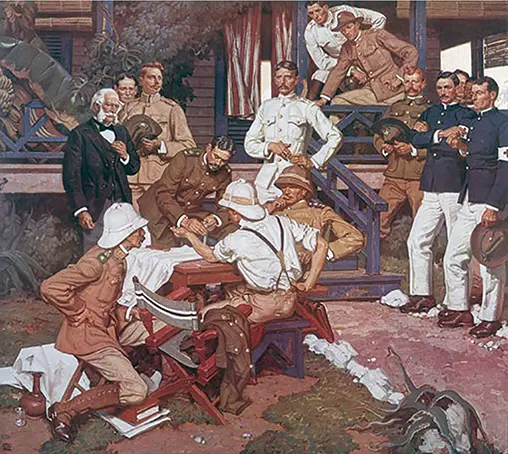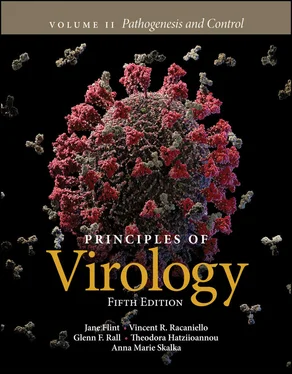S. Jane Flint - Principles of Virology, Volume 2
Здесь есть возможность читать онлайн «S. Jane Flint - Principles of Virology, Volume 2» — ознакомительный отрывок электронной книги совершенно бесплатно, а после прочтения отрывка купить полную версию. В некоторых случаях можно слушать аудио, скачать через торрент в формате fb2 и присутствует краткое содержание. Жанр: unrecognised, на английском языке. Описание произведения, (предисловие) а так же отзывы посетителей доступны на портале библиотеки ЛибКат.
- Название:Principles of Virology, Volume 2
- Автор:
- Жанр:
- Год:неизвестен
- ISBN:нет данных
- Рейтинг книги:3 / 5. Голосов: 1
-
Избранное:Добавить в избранное
- Отзывы:
-
Ваша оценка:
- 60
- 1
- 2
- 3
- 4
- 5
Principles of Virology, Volume 2: краткое содержание, описание и аннотация
Предлагаем к чтению аннотацию, описание, краткое содержание или предисловие (зависит от того, что написал сам автор книги «Principles of Virology, Volume 2»). Если вы не нашли необходимую информацию о книге — напишите в комментариях, мы постараемся отыскать её.
Volume I: Molecular Biology
Volume II: Pathogenesis and Control
Principles of Virology, Fifth Edition
Principles of Virology, Volume 2 — читать онлайн ознакомительный отрывок
Ниже представлен текст книги, разбитый по страницам. Система сохранения места последней прочитанной страницы, позволяет с удобством читать онлайн бесплатно книгу «Principles of Virology, Volume 2», без необходимости каждый раз заново искать на чём Вы остановились. Поставьте закладку, и сможете в любой момент перейти на страницу, на которой закончили чтение.
Интервал:
Закладка:
The first real advance in establishing the origin, or etiology, of yellow fever came in 1880, when the Cuban physician Carlos Juan Finlay proposed that a bloodsucking insect, most likely a mosquito, played a part in the transmission of the dis ease. A commission to study the basis of yellow fever was established in 1899 in Cuba by the U.S. Army under Colonel Walter Reed. This commission was formed in part because of the high incidenceof the disease among soldiers who at that time were stationed in Cuba. Jesse Lazear, a member of Reed’s commission, confirmed Finlay’s hypothesis when he allowed himself to be bitten by a yellow fever virus-infected mosquito. “I rather think I am on the track of the real germ,” wrote Lazear to his wife, sadly just days before he died of yellow fever himself. The results of the Reed Commission’s study proved conclusively that mosquitos are the vectorsfor this disease. In retrospect, a mosquito-borne mode of transmission made sense, as the disease was predominantly found in warm and humid regions (e.g., Cuba, New Orleans) where mosquitos were, and remain, abundant. The members of this courageous team, perhaps the first true epidemiologists, are depicted in a dramatic 1939 painting ( Fig. 1.1).
The nature of the pathogen was established in 1901, when Reed and James Carroll injected diluted, filtered serum from the blood of a yellow fever patient into three healthy individuals. Two of the volunteers developed yellow fever, leading Reed and Carroll to conclude that a “filterable agent,” which we now know as yellow fever virus, was the cause of the disease. In the same year, a professor at the University of Havana attempted to produce immunity by exposing volunteers to mosquitos that were allowed to take a blood meal from an individual who showed signs of yellow fever. Of 19 volunteers, 8 contracted the disease, and 3 died. One of the deceased was Clara Louise Maass, a U.S. Army nurse. Maass’s story is of interest, as she had volunteered to be inoculated by infected mosquitos some time before, developed only mild symptoms, and survived. Her agreement to be infected a second time was to test if her earlier exposure provided protection from a subsequent challenge. This was a prescient idea, because at that time, virtually nothing was known about immune memory, which is the underlying principle of vaccines. Maass’s death prompted a public outcry and helped to end yellow fever experiments in human volunteers.

Figure 1.1 Conquerors of yellow fever. This painting by Dean Cornwell (1939) depicts the experimental exposure of James Carroll to infected mosquitos. Walter Reed, in white, stands at the head of the table, while Jesse Lazear applies the infected mosquitos to Carroll’s arm. Also depicted in this painting is Carlos Finlay, in a dark suit. Despite the care that Cornwell took to ensure accuracy of his portrayal of the participants and their uniforms, the event documented in this painting never took place; rather, artistic license was used to place all the major players in one depiction of a watershed moment in medical history. Courtesy of the Cornwall Historical Society, accessed April 1, 2020, http://www.cornwallhistoricalsociety.org/omeka/items/show/241.
Yellow fever had been endemicin Havana for many years, but the conclusions of Reed and his colleagues about the nature of the pathogen, and the vector that transmitted it, led to rapid implementation of effective mosquito control measures that dramatically reduced the incidence of disease within a year. To this day, mosquito control remains an important method for preventing yellow fever, as well as other viral diseases transmitted by arthropod vectors ( Box 1.2).
Other human viruses were identified during the early decades of the 20th century ( Fig. 1.2). However, the pace of discovery was slow, in great part because of the dangers and difficulties associated with experimental manipulation of human viruses so vividly illustrated by the experience with yellow fever virus. Consequently, agents of some important human diseases were not identified for many years, and then only with some good luck.
A classic example is the identification of the virus responsible for influenza, a name derived in the mid-1700s from the Italian language because of the belief that the disease resulted from the “influence” of contaminated air and adverse astrological signs. Worldwide epidemics ( pandemics) of influenza had been documented in humans for well over 100 years. Such pandemics were typically associated with mortality among the very young and the very old, but the 1918–19 pandemic following the end of World War I was especially devastating. It is estimated that one-fifth of the world’s population was infected, resulting in more than 50 million deaths, far more than were killed in the preceding war. Unlike in previous epidemics, healthy young adults were often victims ( Fig. 1.3).
BOX 1.2
BACKGROUND
Mosquito control measures
In the 1930s, a vaccine was developed for yellow fever virus that dramatically reduced the mortality associated with infection by this virus. Nevertheless, mosquitos remain a primary vector for transmission to humans of viruses for which vaccines do not exist, including Zika and chikungunya viruses, as well as the parasite that causes malaria. Consequently, mosquito control remains a major public health initiative worldwide, but these ubiquitous flying syringes pose a formidable challenge to such efforts.
As mosquitos breed in standing water, reducing the prevalence of seemingly innocuous water traps such as old tires, inflatable pools, birdbaths, clogged gutters, and dis carded soda bottle caps can have a substantial impact on mosquito populations. However, such strategies are likely to be only moderately effective in humid, rainy, or swampy environments. Mosquito netting, with a maximum effective mesh size of 1.2 millimeters, has proven effective when hung over beds or incorporated into tents, and variants of this physical barrier were in effect even in the time of Cleopatra. Similarly, the widespread use of insecticides and repellents has reduced spread of mosquito-borne infections.
Recently, more-creative strategies for mosquito control have been added to the anti-mosquito arsenal, including biocontrol, the use of natural enemies to manage mosquito populations. For example, certain fish, lizards, and other insects, such as dragonflies, feed on mosquito larvae. Their presence may thus help to limit populations naturally, although careless introduction of these species into mosquito-rich environments could de stabilize fragile ecosystems. Genetic manipulation of the mosquitos themselves is an active area of research: studies are ongoing to breed and then release large numbers of sterile male mosquitos; females that mate with a sterile male produce no offspring, thus reducing the next generation’s population size. An even more sophisticated control has been the development of genetically modified strains that require an antibiotic to develop beyond the larval stage. Modified males develop normally when provided with the antibiotic in nurseries. However, when the males are released into the wild and mate with normal females, the genetic vulnerability is transferred to future generations in an environment where the antibiotic is not available. As a result, progeny maturation cannot occur. In April 2014, Brazil’s National Technical Commission for Biosecurity approved the commercial release of a genetically modified mosquito, and the U.S. Food and Drug Administration is considering such measures in the United States.
Читать дальшеИнтервал:
Закладка:
Похожие книги на «Principles of Virology, Volume 2»
Представляем Вашему вниманию похожие книги на «Principles of Virology, Volume 2» списком для выбора. Мы отобрали схожую по названию и смыслу литературу в надежде предоставить читателям больше вариантов отыскать новые, интересные, ещё непрочитанные произведения.
Обсуждение, отзывы о книге «Principles of Virology, Volume 2» и просто собственные мнения читателей. Оставьте ваши комментарии, напишите, что Вы думаете о произведении, его смысле или главных героях. Укажите что конкретно понравилось, а что нет, и почему Вы так считаете.



